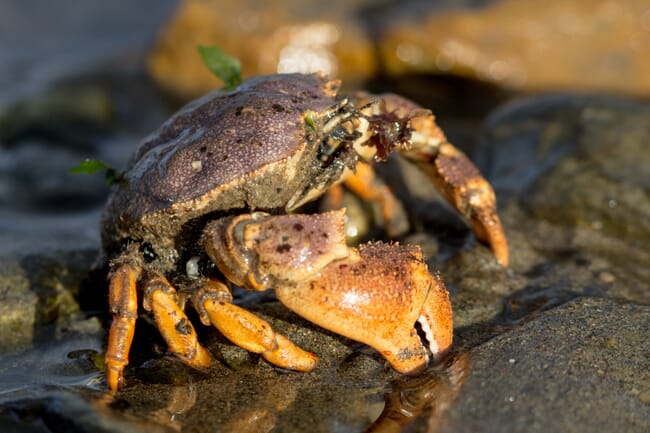Ore (mineral-rich rock) is usually refined by smelting to extract the valuable compounds, but retrieving REEs involves an expensive process that uses toxic and sometimes radioactive chemicals which often end up polluting the environment. However, the scientists discovered that salmon sperm has phosphate in its DNA and decided to see whether this had potential for the mining industry, following previous studies which showed that phosphate on the surface of some bacteria extracted rare earth elements from ores.
To test the idea, they poured dried salmon milt into a beaker containing liquid ore waste. The semen did indeed absorb several rare elements from the solution, which were easily extracted using a centrifuge. The process was accomplished 10 times more efficiently than the more hazardous and costly conventional methods.
The scientists claim salmon sperm could someday replace the toxic brew of chemicals currently used to extract REEs. But before it can be used for extraction on a commercial scale, the researchers said an economically viable process would have to be put in place to capture it from commercial fisheries. The team noted that in its dried form, salmon sperm is very easily stored.

Meanwhile, another group of scientists at the University of Cincinnati recently discovered that LEDs can be intensified by using biological materials – notably, salmon sperm. It is the unique shape of the salmon DNA that produces the bio-magic, said Dr Andrew Steckl, a photonics expert at the university.
“The salmon’s double helix has some interesting properties regarding light. Because of the way it is shaped, you can insert light emitting molecules within it that operate more efficiently than in other host materials,” Steckl said in a phone interview.
Steckl’s studies, in collaboration with US Air Force researchers, used sperm taken from wild salmon in Japan, where it is widely harvested for its DNA. In Steckl’s lab, researchers refined the DNA molecules into pure fibers, then into thin films of tightly controlled dimensions that produce light.
“Starting with this material, you can actually make a competitive, if not a superior device,” he said. “People in the semi-conductor and in flat panel display industries are quite concerned that certain specialty metals that are critical to device fabrication are going to begin to run out. And this is not 100 years from now, this is maybe as soon as 10 years from now.”
Steckl said bioorganic materials are abundant and readily available, and reduce the need for heavy metals and other hazardous materials.
“We have the biggest and most competitive industries in America in agriculture and fishing, producing huge amounts of biomaterials that have many technologically important qualities — electronic, optical, structural, magnetic and more,” he said.
Steckl believes the trend towards ‘biomimetics’ is inevitable.
“Mother Nature’s bounty is widely available and renewable,” he said. “We can use the naturally occurring molecules as a model to learn how they operate. They’ve had millions of years of refining their operations. If we understand how they operate, maybe we can mimic them using man-made materials. We are just scratching the surface.”

Crabs can hear
Creepy soundtracks of noises made by predators had mud crabs running for shelter and proved, for the first time, that the animals can hear. Marine acoustic experts at Boston’s Northeastern University made the discovery in lab tests on 200 mud crabs during a two-year study.
When they piped in certain noises, the crabs didn’t dare venture out to eat juicy clams placed in their tanks and their skittishness lasted for several hours. The scientists said the crabs hear through a small sac at the base of their antennae called a statocyst, which contains thousands of sensory hairs important for the animal’s balance but also, the study found, for responding to sounds.
Might it be the same for Alaska crab?
“That’s unknown. I’m not aware of any studies that have gone into that level of detail on the sensory organs or abilities of any of the commercial crab species in Alaska,” said Bob Foy, director of NOAA Fisheries top crab lab at Kodiak.
“I would not be surprised if it was the same,” he added. “Sound is just a pressure wave, so I’m not surprised that the crab can hear the sound. The interesting fact is how they are reacting to a predator or to another organism, and being able to measure the stress that the animal is undergoing at the same time.”
Other studies showed that ship sounds affected foraging behavior of shore crabs. Foy said all of the findings can be important for crab scientists and managers on a couple of fronts.
“Just knowing that the animals have that additional sensory capability is huge for us to understand how they are interacting with their environment. Crab communication is very important,” he explained. “We are trying to understand the behavior of the crab, such as how the males and females find each other. Crabs don’t broadcast spawn like a fish does; they have to find each other in a very large ocean. So knowing more about their hearing behaviors would be critical for understanding how these animals are moving throughout their environment.”
The impacts of sonar usage for oil/gas exploration, ships and other kinds of ocean noises also could be assessed, Foy said.
“Knowing that crabs do have this hearing sensitivity helps us think about how we might test for these things,” he reflected.
Foy called the crab hearing studies “fascinating” and hopes they continue.
“If you had asked me if crabs can hear prior to this, I probably would have said they probably have a way of detecting sound,” he said. “But seeing how they are detecting it and then responding to noises and other predators is very intriguing in terms of how we might be able to use this in the future.”



